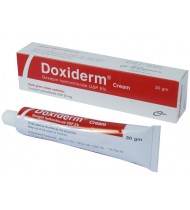Doxepin (Topical)
Indications
Doxepin cream is indicated for the short-term (upto 8 days) management of moderate pruritus in adult patients with atopic dermatitis or lichen simplex chronicus.
Pharmacology
Doxepin hydrochloride is one of a class of agents known as dibenzoxepin tricyclic antidepressant compounds. Although doxepin HCl does have H1 and H2 histamine receptor blocking actions, the exact mechanism by which doxepin exerts its antipruritic effect is unknown. It can produce drowsiness in significant numbers of patients, and this sedation may reduce awareness, including awareness of pruritic symptoms.
Dosage & Administration
Adult and child over 12 years: apply thinly 3–4 times daily; usual max. 3 g per application; usual total max. 12 g daily; coverage should be less than 10% of body surface area.
Interaction
Concomitant use of tricyclic antidepressants with drugs that can inhibit cytochrome P450 2D6 like MAO inhibitors, cimetidine, alcohol may require lower doses than usually prescribed for either the tricyclic antidepressant or the other drug. MAO inhibitors should be discontinued at least two weeks prior to the cautious initiation of therapy with Doxepin cream.
Contraindications
Patients with untreated narrow angle glaucoma or a tendency to urinary retention because doxepin has an anticholinergic effect
Individuals who have shown previous sensitivity to any of its components
Individuals who have shown previous sensitivity to any of its components
Side Effects
Drowsiness, local burning, stinging, irritation, tingling, rash; systemic side-effects such as antimuscarinic effects, headache, fever, dizziness, gastro-intestinal disturbances has been reported.
Pregnancy & Lactation
Pregnancy: Category B- There are no adequate and well-controlled studies in pregnant women. This drug should be used during pregnancy only if clearly needed.
Nursing Mothers: Doxepin is excreted in human milk after oral administration. It is possible that doxepin may also be excreted in human milk following topical application of Doxepin cream.
Nursing Mothers: Doxepin is excreted in human milk after oral administration. It is possible that doxepin may also be excreted in human milk following topical application of Doxepin cream.
Precautions & Warnings
Cautions should be exercised if there is susceptibility to angle-closure glaucoma, urinary retention, severe liver impairment, mania and also in pregnancy and breast-feeding. Drowsiness may affect performance of skilled tasks (e.g. driving) so patient should be careful.
Use in Special Populations
Use in Children: The use of Doxepin cream in pediatric patients is not recommended. Safe conditions for use of cream in children have not been established.
Use in Elderly Patients: Dose selection for an elderly patient should be cautious, usually starting at the low end of the dosing range, reflecting the greater frequency of decreased hepatic, renal or cardiac function, and of concomitant disease or other drug therapy.
Use in Elderly Patients: Dose selection for an elderly patient should be cautious, usually starting at the low end of the dosing range, reflecting the greater frequency of decreased hepatic, renal or cardiac function, and of concomitant disease or other drug therapy.
Overdose Effects
If overdosage with topical application of Doxepin cream occur, the signs and symptoms may include cardiac dysrhythmias, severe hypotension, convulsions, and CNS depression, including coma. Changes in the electrocardiogram, particularly in QRS axis or width, are clinically significant indicators of tricyclic antidepressant toxicity. Other signs of overdose may include confusion, disturbed concentration, transient visual hallucinations, dilated pupils, agitation, hyperactive reflexes, stupor, drowsiness, muscle rigidity, vomiting, hypothermia, hyperpyrexia.
Therapeutic Class
Local Antipruritic
Doxiderm Cream 30 gm tube
IndicationsDoxepin cream is indicated for the short-term (upto 8 days) management of moderate prurit..
120.00Tk.
Showing 1 to 1 of 1 (1 Pages)

